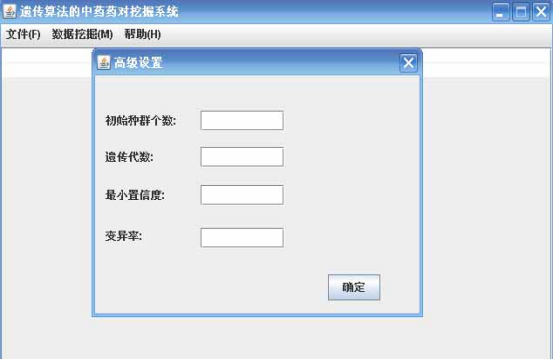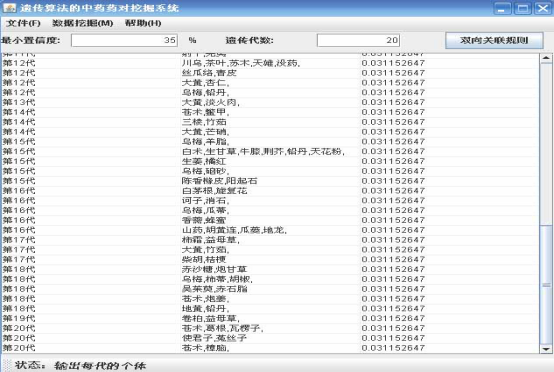基于Java遗传算法的中药药对药组挖掘系统设计与实现
摘 要
用数据挖掘技术研究了中药方剂配伍的规律。主要工作:分析了关联规则存在的问题,引入双向关联规则的概念;介绍了遗传算法的基本原理,研究了遗传算法在数据挖掘中的应用;将方剂库转换为位图矩阵,大大提高搜索效率;开发了一个基于遗传算法的中药药对药组挖掘系统。论文组织如下:介绍了研究背景和意义;阐述了相关的理论基础;提出了系统的设计方案;详细展示了基于遗传算法的双向关联规则挖掘系统的实现过程,包括位图矩阵的实现,个体的编码方法,适应度函数的设计,规则的提取,选择、交叉、变异等遗传操作的实现等;利用脾胃类方剂库对系统进行了测试,并对测试结果进行了分析。结果证明:该系统能够快速高效地从方剂库中找出具有重要意义的药对药组,对中医药的研究发展有一定意义。
关键词:数据挖掘;置信度;双向关联规则;遗传算法
The Design and Implementation of Chinese Medicine Groups Mining System based on Genetic Algorithm
Abstract
This paper researches the compatibility of chinese medicine prescriptions by data mining techniques. The main contributions include: analyzes the problems in the association rules, and introduces the concept of the bidirectional association rule; presents the foundation principle of genetic algorithm(GA), and studys the application of GA in the data mining; converts chinese medicine prescriptions database to a bitmap matrix, which greatly enhances the efficiency of search; develops a chinese medicine groups mining system based on GA. The paper is organized as follows: Section 1 introduces the background and significance; Section 2 sets forth the basis of the relevant theories; Section 3 proposes the design project of the system; Section 4 detailedly shows the implementation of the system, including the implementation of bitmap matrix, the individual coding method, the design of fitness function, rules of the extraction, genetic operations. Section 5 gives a test of the system on the prescriptions database about spleen and stomach, and analyzes the results. It is proved that this system can find important and significant Chinese Medicine Groups from the prescriptions database, and is meaningful for the research of Chinese medicine.
Key words: Data mining; Confidence; Bidirectional association rule; Genetic algorithm
目 录
论文总页数:24页
1 引言 1
1.1 背景 1
1.2 意义 1
2 理论基础 1
2.1 关联规则及存在的问题 1
2.2 双向关联规则 2
2.3 遗传算法简介 4
3 需求分析及设计方案 5
4 基于遗传算法的双向关联规则挖掘算法具体流程及实现 7
4.1 位图矩阵实现 7
4.2 编码 9
4.3 适应度函数 11
4.3.1 适应度函数设计 11
4.3.2 适应度函数的实现 11
4.4 规则的提取 14
4.5 遗传操作 15
4.6 算法流程 18
5 测试 18
结 论 21
参考文献 22
致 谢 23
声 明 24















